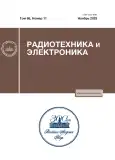On the Problems of Monitoring Atmospheric Humidity Fields Using Satellite Microwave Radiometry Methods When Studying Cyclogenesis in the Tropical Atlantic
- Авторлар: Grankov A.G.1, Novichikhin E.P.1, Shelobanova N.K.1
-
Мекемелер:
- Kotelnikov Institute of Radioengineering and Electronics, Fryazino Branch, Russian Academy of Sciences
- Шығарылым: Том 68, № 11 (2023)
- Беттер: 1072-1078
- Бөлім: СТАТИСТИЧЕСКАЯ РАДИОФИЗИКА
- URL: https://journals.rcsi.science/0033-8494/article/view/232604
- DOI: https://doi.org/10.31857/S0033849423110049
- EDN: https://elibrary.ru/IHJZEM
- ID: 232604
Дәйексөз келтіру
Толық мәтін
Аннотация
Some problems of microwave radiometric methods for monitoring fields of total atmospheric moisture content from satellites in areas of hurricane formation in the tropical regions of the Atlantic are considered. The possibilities of using polar-orbiting satellites (DMSP, EOS Aqua, GCOM-W1) for these tasks are analyzed a feature of which is the presence of gaps in satellite data (blind spots) resulting from divergence of scanning bands at lower latitudes. It is shown through a number of examples that the joint use of various satellites makes it possible to reduce the influence of this effect and obtain a clear picture of the evolution of atmospheric humidity fields in the tropical Atlantic and their connection with the evolution of tropical waves that initiate the formation of hurricanes.
Авторлар туралы
A. Grankov
Kotelnikov Institute of Radioengineering and Electronics, Fryazino Branch, Russian Academy of Sciences
Email: agrankov@inbox.ru
141190, Fryazino, Moscow oblast, Russia
E. Novichikhin
Kotelnikov Institute of Radioengineering and Electronics, Fryazino Branch, Russian Academy of Sciences
Email: agrankov@inbox.ru
141190, Fryazino, Moscow oblast, Russia
N. Shelobanova
Kotelnikov Institute of Radioengineering and Electronics, Fryazino Branch, Russian Academy of Sciences
Хат алмасуға жауапты Автор.
Email: agrankov@inbox.ru
141190, Fryazino, Moscow oblast, Russia
Әдебиет тізімі
- Ермаков Д.М., Раев М.Д., Чернушич А.П., Шарков Е.А. // Исслед. Земли из космоса. 2013. № 4. С. 72.
- Ермаков Д.М., Шарков Е.А., Чернушич А.П. // Исслед. Земли из космоса. 2016. № 3. С. 37.
- Гранков А.Г., Мильшин А.А. // РЭ. 2022. Т. 67. № 7. С. 660.
- Hollinger P.H., Peirce J.L., Poe G.A. // IEEE Trans. 1990. V. GRS-28. № 5. P. 781.
- Kunkee D., Boucher, D., Poe, G. et al. // IEEE Trans. 2008. V. GRS-46. № 4. P. 863.
- Kawanishi T., Sezai T., Ito Y. et al. // IEEE Trans. 2003. V. GRS-41. № 7. P. 173.
- Lawrence M.B., Kimberlain T.B. Tropical Cyclone Report: Hurricane Bret, 18–25 August 1999. Miami: National Hurricane Center. https://www.nhc.noaa.gov/ data/tcr/AL022011_Bret.pdf.
- Хромов С.П., Мамонтова Л.И. Метеорологический словарь. Л.: Гидрометеоиздат, 1974.
- Beven II J.L. Tropical Cyclone Report: Hurricane Frances, 25 August–8 September 2004. Miami: National Hurricane Center. https://www.nhc.noaa.gov/ data/tcr/AL062004_Frances.pdf.
- Cangialosi J.P., Latto A.S., Berg R. Tropical Cyclone Report: Hurricane Irma, 30 August–12 September 2017. Miami: National Hurricane Center 24 September 2021.
Қосымша файлдар














